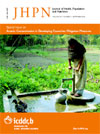
|
The Journal of Health, Population and Nutrition
icddr,b
ISSN: 1606-0997
EISSN: 1606-0997
Vol. 36, No. 1, 2017, pp. 1-7
|
 Bioline Code: hn17014
Bioline Code: hn17014
Full paper language: English
Document type: Research Article
Document available free of charge
|
|
|
The Journal of Health, Population and Nutrition, Vol. 36, No. 1, 2017, pp. 1-7
| en |
Detection and identification of antimicrobial-resistant Salmonella  in raw beef at Wolaita Sodo municipal abattoir, Southern Ethiopia in raw beef at Wolaita Sodo municipal abattoir, Southern Ethiopia
Wabeto, Wondimu; Abraham, Yishak & Anjulo, Antehun Alemayehu
Abstract
Background: The consumption of multidrug resistant Salmonella isolates along with a raw meat dish is directly
relevant to the global public health crisis of antimicrobial resistance. All countries around the globe are suffering
from food-borne diseases. In developing countries, more than one billion individuals suffering from gastroenteritis
and around five million infected individuals die annually.
Methods: A cross-sectional study was carried out from December 2015 to May 2016 to show the risk of Salmonella
associated with consuming traditional raw meat dishes and to characterize the antimicrobial resistance profile at
Wolaita Sodo municipal abattoir. Animals were being processed as part of the normal work of the abattoir, and
448 carcass samples were taken after getting a written consent from the municipality. Samples were transported
to Wolaita Sodo University Microbiology Laboratory in an ice box within an hour of collection. Swab samples were
pre-enriched in tetrathionate broth and Rappaport-Vassiliadis R10 broth. Broth culture was sub-cultured on xylose
lysine deoxycholate and brilliant green agar and incubated at a temperature of 37 °C for overnight. Antimicrobial
susceptibility test was done by disk diffusion method. Microbiological and observational data entry and analysis
were done using Microsoft Excel 2007.
Results: From the total 448 sampled carcasses, Salmonella growth was observed in 56 (12.5%) samples.
The isolates had various resistance profiles, with resistance to 1 to 12 antimicrobial drugs. Tetracycline- and
nitrofurantion-resistant isolates were frequent, 83.93 and 73.21% respectively, and followed by streptomycin-resistant
isolates (66%). Ciprofloxacin-resistant isolates were rare (7%).
Conclusion: Salmonella species contamination frequency was high in raw beef, and most of the isolates exhibited
resistance to commonly used antibiotics. People living in the town and consuming the raw meat are at risk for
developing diseases, and attention should be given to select antimicrobials in treating Salmonella infections in both
animals and human being based on antimicrobial susceptibility test. Moreover, intersectoral working and developing
one health approach is essential. Health information should be given to individuals who have the habit of eating raw
meat. Training on sanitary and hygiene practice should be given to the abattoir workers.
Keywords
Antimicrobial susceptibility pattern; Beef; Abattoir; Isolation; dentification; Salmonella spp.
|
| |
© Copyright 2017 - The Author(s)
Alternative site location: http://www.jhpn.net
|
|
